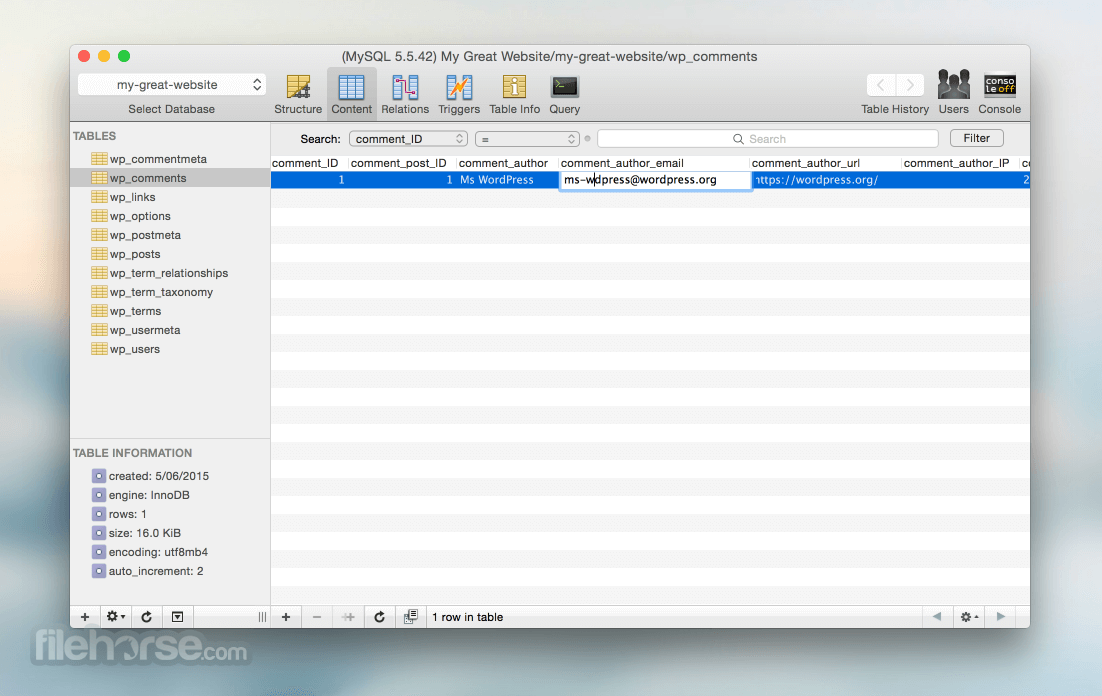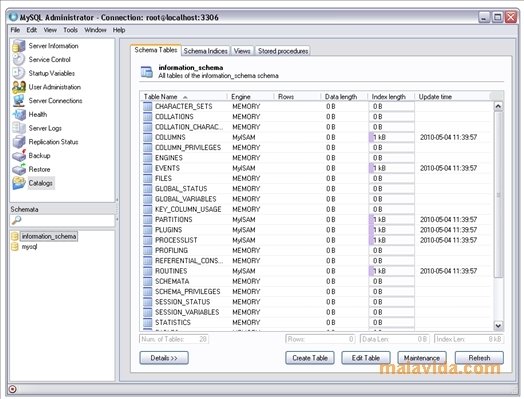Download Mysql For Mac

In this tutorial, we are going to learn how to install MySQL community server on Mac and setting up the MySQL in Terminal app.


Install MySQL Server for Mac, instructions and download here. Once MySQL is installed, the first thing to do is Start the MySQL Server. From System Preferences, open MySQL, click on Initialize. Toad for MySQL empowers MySQL developers and administrators develop code more efficiently. It also provides utilities to compare, extract and search for objects, manage projects, import/export. For Mac OS The package has been set up to be very easy to install and to use like Windows OS. To install and run it on Mac OS download offline installer setup. It is an easy to install Apache distribution for Mac OS X. The package for Mac is similar to windows. It includes the Apache web server, MySQL, PHP, Perl, an FTP server and phpMyAdmin.
Mac OS doesn’t come along with the pre-configured version of MySQL, but this step by step guide will make the task easy for you. By the end of this tutorial, you will be able to set up the MySQL server on your Mac system for local development purposes.
Download MySQL Server
Before we start installing MySQL server on mac, we first download the latest version of MySQL from its official site.
Visit https://dev.mysql.com/downloads/mysql and choose the MySQL version that you want to download.
On this page, you will see list of operating systems under the “Select Operating System” dropdown choose the macOS from the list. Then, click on the download button for the MySQL .dmg file. You can download the other MySQL instances as per your operating system requirement.
Install MySQL on Mac
You have to click on the MySQL file to install the MySQL on Mac system. You might get the warning “macOS cannot verify that this app is free from malware”.
To get rid from this issue got to System Preferences > Security & Privacy and click on the “Open Anyway” button. This will allow you to install the MySQL version in your system.
Once the MySQL installation is completed, go to System Preferences and click on the MySQL icon that you can see on the bottom left position.
Here you can see the MySQL is already running and other configurations of MySQL. You can even stop the server by clicking on “stop MySQL server”. Well this is not the only way to start the server, we can even manually start the MySQL server via command line.
Configure MySQL in Mac for Terminal App
To start the MySQL via terminal app, you need to use the following command.
But this command will display the following error on your terminal screen.
“command not found: mysql.server”
To fix this issue, we have to define the MySQL path in the paths file. The easiest way to open the file is to type the following command in the terminal and provide the password.
Include one per line given below paths in the /etc/paths file.
Next, type the command to start the MySQL server.
Here is the output we get when MySQL is started correctly.
We used `sudo` with mysql.server start otherwise it will throw permission errors.
Important MySQL Commands
Here are the important commands that are often used while working with MySQL.
Run the following command to stop mysql server:
Type the below command to restart the MySQL server that is already running:
To verify the current status of MySQL server:
Access Root via Mac Terminal & Create Database

Now, we have reached to essential step of our tutorial. We are all set with the server configurations, now we have to access the MySQL root. When you run the following command it will ask for the password. So you have to type the password that you defined when installing the MySQL initially.
Now we will use the mysql query to create a new database.
You can verify the newly created MySQL database.
Use the newly created “positrondb” db by using the below command.
Create a table in the MySQL database =>‘positrondb’.
Verify the table in the database.
Summary
We have completed the MySQL tutorial, and In this tutorial, we learned how to install MySQL community server on Mac OS, How to access root user in the MySQL server, Create Database and Table.
I hope you liked this tutorial, dont forget to share it with others.
MySQL Community Edition is the freely downloadable version of the world's most popular open source database. It is available under the GPL license and is supported by a huge and active community of open source developers.
The MySQL Community Edition includes:
- SQL and NoSQL for developing both relational and NoSQL applications
- MySQL Document Store including X Protocol, XDev API and MySQL Shell
- Transactional Data Dictionary with Atomic DDL statements for improved reliability
- Pluggable Storage Engine Architecture (InnoDB, NDB, MyISAM, etc)
- MySQL Replication to improve application performance and scalability
- MySQL Group Replication for replicating data while providing fault tolerance, automated failover, and elasticity
- MySQL InnoDB Cluster to deliver an integrated, native, high availability solution for MySQL
- MySQL Router for transparent routing between your application and any backend MySQL Servers
- MySQL Partitioning to improve performance and management of large database applications
- Stored Procedures to improve developer productivity
- Triggers to enforce complex business rules at the database level
- Views to ensure sensitive information is not compromised
- Performance Schema for user/application level monitoring of resource consumption
- Information Schema to provide easy access to metadata
- MySQL Connectors (ODBC, JDBC, .NET, etc) for building applications in multiple languages
- MySQL Workbench for visual modeling, SQL development and administration
Download Sql For Mac
Available on over 20 platforms and operating systems including Linux, Unix, Mac and Windows.
